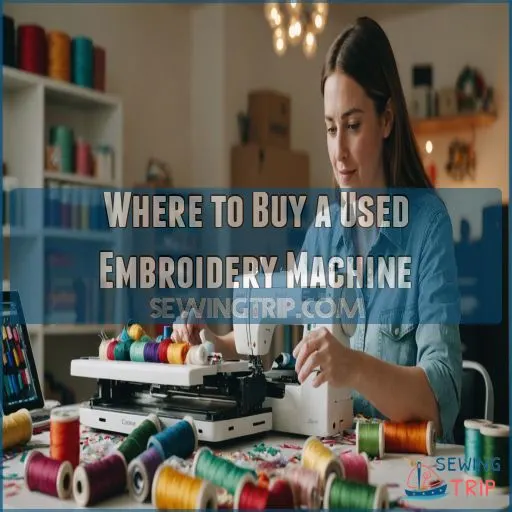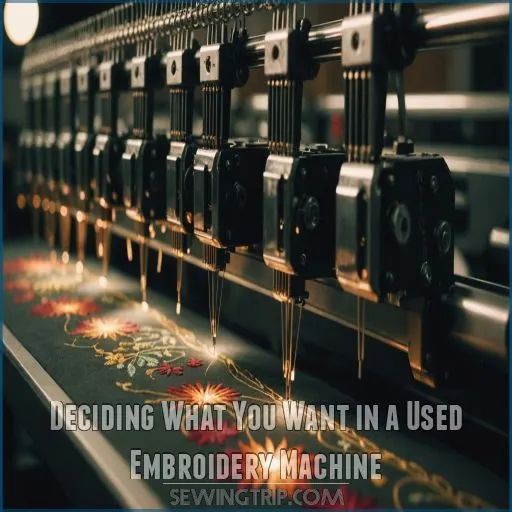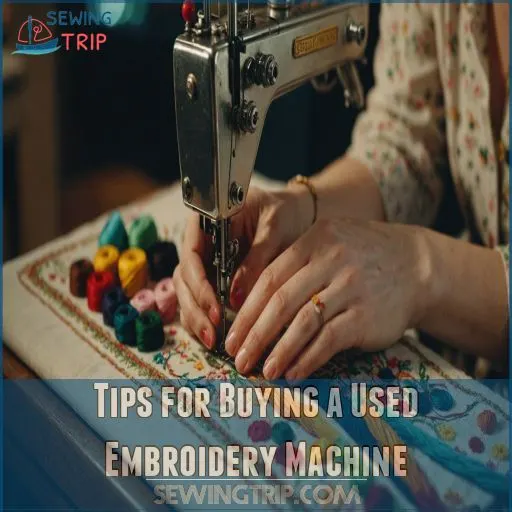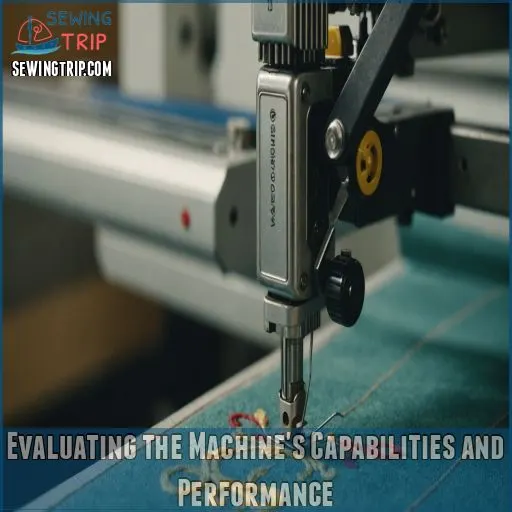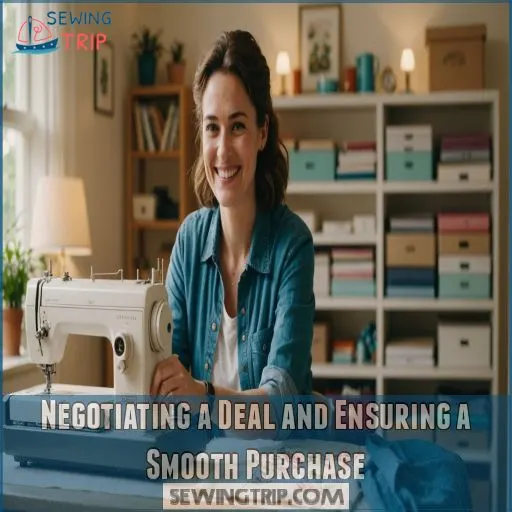This site is supported by our readers. We may earn a commission, at no cost to you, if you purchase through links.
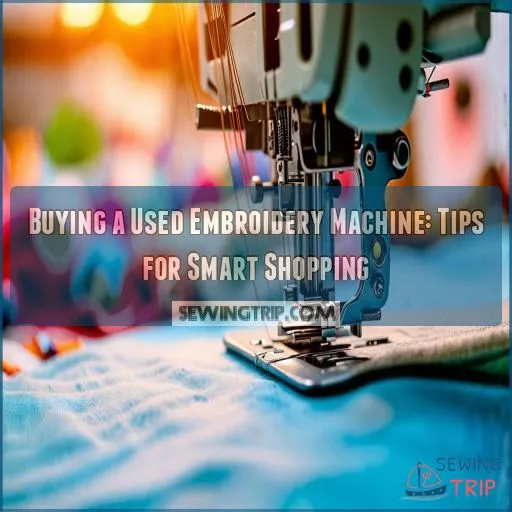
Local dealers or certified refurbished online options often offer warranties, making them a safer bet. Don’t shy away from thrift shops; sometimes, you’ll find gems if you give them a test drive.
Check the machine’s age and repair part availability—it’s like finding a unicorn when everything aligns just right. Inspect for wear and tear, and always haggle politely—there’s usually some wiggle room.
Curious about getting the best deal while ensuring quality? There’s more than one thread in this story!
Table Of Contents
- Key Takeaways
- Where to Buy a Used Embroidery Machine
- Deciding What You Want in a Used Embroidery Machine
- Tips for Buying a Used Embroidery Machine
- Evaluating the Machine’s Capabilities and Performance
- Determining the Machine’s Capabilities and Comparing to Your Needs
- Researching Prices of Similar Machines in the Market
- Factoring in the Cost of Potential Repairs or Upgrades
- Evaluating Stitch Quality, Design Options, and Hoop Compatibility
- Considering the Machine’s Speed, Efficiency, and User-Friendliness
- Negotiating a Deal and Ensuring a Smooth Purchase
- Frequently Asked Questions (FAQs)
- Conclusion
Key Takeaways
- When buying a used embroidery machine, start by knowing what you need—think of it like setting up a taco bar with the right mix of ingredients; you need the right hoop size, stitch speed, and brand to satisfy your creative hunger.
- Don’t shy away from certified refurbished machines or local dealers, as they often come with warranties, ensuring you don’t end up with a dud—it’s like having a mechanic’s blessing before buying a used car.
- Keep an eye on the machine’s age and part availability; it’s akin to collecting classic cars—older models are charming but might need more upkeep, so ensure that parts are not as rare as hen’s teeth.
- Haggle politely, whether you’re at a garage sale or online; think of it as a chance to practice your negotiation skills, like getting free guacamole added to your burrito bowl.
Where to Buy a Used Embroidery Machine
When you’re on the hunt for a used embroidery machine, you’ve got plenty of options ranging from local dealers to online marketplaces.
Just remember, whether you’re bartering at a garage sale or scrolling through eBay, always check for warranties and test the machine if you can.
Because nobody wants a stitching surprise!
Local Dealers and Authorized Resellers
You’re considering a pre-owned embroidery machine, right?
Local dealers and authorized resellers are your best bet. Their solid dealer reputation guarantees reliability and often comes with warranty options and service history checks.
Inspect that machine closely, and don’t forget a pricing comparison. You might even find a certified used embroidery machine that’s practically new!
Happy hunting!
Certified Refurbished or Renewed Online Options
Find great deals by exploring certified refurbished options online. These machines come with warranties and reliable return policies, offering peace of mind.
Check these out:
- Amazon and eBay: Compare prices and conditions.
- Manufacturer Websites: Look for brands like Brother offering certified machines.
- Reputable Dealers: Sites like Ken’s Sewing Center provide quality assurance.
Online Marketplaces and Direct Sales
Browsing eBay or Craigslist for a used embroidery machine? It’s like diving into a treasure chest—you might find a gem or a dud.
Check seller reputation and use buyer protection. Don’t shy away from negotiation tips.
Sure, there are potential risks, but success stories abound. Approach each embroidery machine deal like a seasoned pirate seeking treasure!
Thrift Shops, Garage Sales, and Resale Stores
A thrifter’s paradise, local charity shops, garage sales, and resale stores can uncover hidden gems for the savvy embroidery enthusiast.
Look for:
- Vintage embroidery machines in excellent condition
- Sewing notions, hoops, and accessories at bargain prices
- Rare or discontinued embroidery supplies
- Inspiration from antique linens and textiles
Don’t be afraid to test machines before buying – a little elbow grease can revive a secondhand treasure.
Manufacturer Websites and Refurbished Machines
Manufacturer websites offer refurbished embroidery machines with warranties, guaranteeing you dodge costly lemons. The brands’ reputations soothe your worries like cozy socks for cold feet.
Compare models by checking online reviews and considering the machine’s age. Humorously, it’s like picking a pet—choose wisely for harmony!
| Consideration | Tip |
|---|---|
| Manufacturer | Check brand reputation |
| Warranty | Make sure it’s included |
| Refurbished Cost | Evaluate overall savings |
| Machine Age | Opt for not-too-old models |
Deciding What You Want in a Used Embroidery Machine
When you’re eyeing a used embroidery machine, deciding exactly what you need can feel like picking toppings at an ice cream parlor—fun but also a bit overwhelming.
Start with setting a budget and listing essential features like hoop size, stitch speed, and brand preference to make sure the machine meets both your creative dreams and practical needs without breaking the bank.
Setting a Budget and Listing Your Needs
Before diving into the embroidery world, set a clear budget and know what you need.
Ask yourself:
- Budgeting: What’s your max spend?
- Embroidery Needs: Which projects will you tackle?
- Machine Features: Must-have options?
- Hoop Size and Stitch Count: Essential for your designs.
A little planning now avoids costly surprises later.
Considering Machine Age and Replacement Part Availability
When considering a used embroidery machine, the age of the model and availability of replacement parts are very important.
Older, vintage machines may be more affordable, but finding compatible parts can be a challenge.
Weigh the machine’s condition, repair costs, and support community to make sure you don’t end up with an unreliable workhorse.
Researching Pricing History and Market Trends
Buying used embroidery machines requires savvy research.
Start with these key insights:
- Check eBay pricing trends and Craigslist price comparisons for current market values.
- Hunt down Facebook Marketplace deals and review manufacturer refurbished prices for potential savings.
- Analyze online marketplace trends and read embroidery machine reviews to assess service needs and wear and tear.
Assessing Your Needs and Prioritizing Features
Just like stocking up on popcorn before a movie marathon, you’ll want to list your needs.
Think embroidery machine types and hoop size—vital for tackling those giant monogrammed towels.
Consider the stitch quality and editing capabilities for intricate embroidery designs.
Don’t forget about embroidery software and accessories that streamline your creative process.
Research keeps surprises at bay when shopping!
Tips for Buying a Used Embroidery Machine
When buying a used embroidery machine, you’ll want to thoroughly test it out and inspect it for any issues.
Check the stitch count, last service date, and availability of replacement parts to make sure you’re getting a well-maintained machine that will serve you well.
You are getting a well-maintained machine.
Checking Stitch Count and Last Service Date
Ready to step up your embroidery game?
Consider checking the stitch count and last service date. It’s like buying a car; a low stitch count is a bonus, but a well-maintained machine with millions of stitches might still be a gem.
Regular maintenance keeps it purring like a kitten, impacting buying decisions and predicting overall machine lifespan (Source).
Assessing Replacement Part Availability and Machine Condition
After checking the stitch count, focus on part availability and machine age.
You wouldn’t want your embroidery machine to become a paperweight due to missing parts. Buying a used machine from a reputable seller can also be beneficial, as they may provide some level of support or warranty, although limited compared to a new machine.
Additionally, consider the potential risks of buying a non-working machine and the difficulty of finding replacement parts for older models. Look into its maintenance history for any red flags like constant repairs or embroidery machine damage.
With these checks, you’ll stitch your way to a fantastic deal on quality embroidery equipment.
Inspecting the Machine for Physical Damage or Wear
Frequently overlooked but important, inspect for cracked casing or loose screws on the embroidery machine. These are red flags indicating signs of neglect.
Test stitching quality, listening closely for strange noises—like ghosts arguing in your attic!
Whether it’s a sewing machine or embroidery machine, take some embroidery training or get embroidery support if needed. Stay sharp!
Evaluating the Machine’s Capabilities and Performance
When evaluating a used embroidery machine, you’ll want to determine its capabilities and compare them to your needs.
Check the stitch quality, design options, and hoop compatibility to make sure the machine can handle the projects you have in mind.
Determining the Machine’s Capabilities and Comparing to Your Needs
When you’re getting ready to buy a used embroidery machine, make sure it’s a good fit for your creative projects. Consider stitch quality and user-friendliness; they’re key for smooth operation.
- Stitch Quality: Check for consistency and neatness.
- Hoop Size: Ensure it fits your design plans.
- Design Options: Validate built-in and customizable designs.
- Speed: Balance between pace and precision.
- User-Friendliness: Simplifies complex tasks.
Researching Prices of Similar Machines in the Market
To get the best bang for your buck, check out online marketplaces like eBay, Craigslist, and Facebook Marketplace to check prices of similar embroidery machines.
Don’t forget to browse online forums and manufacturer websites for insights.
It’s like window shopping from your couch! Compare features, age, and condition to make sure you’re stitching the right deal.
Factoring in the Cost of Potential Repairs or Upgrades
You’ve checked prices, now weigh potential repair costs and upgrades.
An older machine might scream for a part replacement or an upgrade to extend its lifespan.
Don’t get caught with hidden expenses because parts availability might surprise you like an unexpected pothole!
Balancing these costs can keep you cruising smoothly on your embroidery journey .
Evaluating Stitch Quality, Design Options, and Hoop Compatibility
Ensuring your embroidery machine stitches like a pro means checking stitch consistency and design variety.
You’ll want hoops that fit your project size—think of it as choosing the perfect pizza crust: not too small.
Opt for a machine with versatile compatibility to handle various fabrics.
A little attention now saves frustration later, trust me, with the right machine having stitch consistency.
Considering the Machine’s Speed, Efficiency, and User-Friendliness
Imagine you’re the captain of your embroidery ship. A speedy, efficient machine can save you heaps of time.
A speedy machine should be watched for overheating if it runs too fast.
User-friendliness is key.
An intuitive interface helps avoid sea-sick frustration.
Compare stitch quality and long-term usability to make sure your purchase sails smoothly through your projects without capsizing your creativity!
Negotiating a Deal and Ensuring a Smooth Purchase
Approach the purchase of a used embroidery machine with the same strategy as haggling at a yard sale—walk in confident, and don’t shy away from bargaining for packages or asking for added lessons.
Be smart by comparing prices and prioritizing warranties to make sure you don’t end up stitching your wallet shut with poor bargaining.
Asking for Packages or Specials From Dealers
When working with a dealer, don’t be afraid to ask about package deals or special offers.
From free accessories to discounted bundles, there may be hidden savings you can uncover.
Dealers often want to move inventory, so they may be willing to negotiate on the price or throw in freebies to sweeten the deal. (Source)
Making a Lower Offer and Negotiating With Sellers
While grabbing specials from dealers is fun, haggling can get you even better deals.
Start by figuring out fair pricing and presenting a well-reasoned lower offer.
Highlight the seller’s reputation and express genuine interest without overplaying your hand.
Use polite negotiation strategies—remember, if the price isn’t right, it’s okay to walk away and pursue other options .
Considering Additional Value With Free Lessons or Support
Don’t overlook free lessons or support when buying a used embroidery machine, especially if they cover machine quilting techniques such as choosing the right stitch length for machine quilting, which can make a big difference in your embroidery projects. Familiarizing yourself with these techniques can help you master your embroidery craft and create beautiful, professional-looking pieces. They’re like a cherry on top.
- Free lessons help conquer learning curves.
- Support resources tackle pesky issues.
- Beginner tips and community forums boost confidence.
- Online tutorials refine skills on lazy Sundays.
Consider these perks to master your embroidery craft.
Comparing Prices From Multiple Sellers and Shopping Around
After eyeing a few embroidery machines with tantalizing extras, grab your device and hop on price comparison tools like Google Shopping or ShopSavvy.
Find the best deals by comparing multiple sellers.
Use sharp negotiation strategies; tossing in a witty anecdote might seal the deal.
Watch for hidden costs that could sneak up later.
Prioritizing Warranty, Return Policy, and Seller Reputation
A wise choice is a seller with a sterling reputation.
Always check these essentials:
- Seller trustworthiness: Browse reviews and ratings.
- Warranty details: Know what’s covered.
- Return policy: Make sure buyer protection is in place.
- Seller history: Look into past transactions.
- Personal anecdotes: Ask friends about their experiences.
Finding these will smooth your path to that perfect embroidery machine.
Frequently Asked Questions (FAQs)
Is it worth buying a second hand embroidery machine?
Snagging a well-maintained, lightly used embroidery machine can save you a bundle.
Just be sure to inspect it thoroughly and ask lots of questions to avoid any hidden issues.
It’s a smart way to get high-quality tech on a budget, which is a great way to find a lightly used embroidery machine. (Source)
How much should I spend on an embroidery machine?
Think of buying an embroidery machine like picking a ballpark in which to play your creative game.
Spend $300-$1,000 for a basic model or invest $1,000-$5,000 for more advanced features and capabilities.
How many stitches is the life of an embroidery machine?
Your embroidery machine’s life is a bit like a marathon runner’s—it can easily handle 40 million stitches between maintenances if well-cared for.
Just remember, frequent tune-ups keep it humming smoothly and happily ever after!
Is an embroidery machine profitable?
Diving into embroidery can be like striking gold.
When you’ve got creativity and the right equipment, profits are substantial, thanks to low supply costs and unique sales opportunities.
Like custom apparel for teams and businesses.
How do I check for software compatibility?
To check software compatibility, first, identify the required file formats and connectivity options for your machine.
Then, make sure your computer meets the software’s system requirements, like operating system and RAM specifications.
A test run‘s invaluable too!
What are common issues with used machines?
Embroidery machines often suffer from timing issues, worn parts, or outdated software, causing frustration.
Imagine the needle breaking mid-design!
Regular maintenance helps, but these quirks can leave your patience thinner than a bobbin thread.
These issues can be particularly problematic for those who rely on their machines for work or other important tasks, and regular maintenance is key to preventing them.
How can I find user reviews?
Think of user reviews as hidden treasures.
Explore online forums like PatternReview and specialized Facebook groups.
Check sites like Yelp or Trustpilot for insights.
Don’t forget to ask fellow enthusiasts for firsthand experiences with used machines.
How do I ensure model authenticity?
Verify the machine’s model number.
Check for any signs of tampering, and ask the seller for proof of purchase.
This will make sure you’re getting an authentic embroidery machine that’ll serve you well.
What maintenance schedule should I follow?
Start by cleaning your embroidery machine after every project.
Oil it monthly, focusing on the bobbin case and needle area.
Schedule a professional check-up annually.
This routine keeps your machine purring like a kitten and stitching smoothly!
Conclusion
Starting the hunt for a used embroidery machine is like stitching together a quilt—piece by piece, everything starts to align.
Focus on your needs, from hoop size to stitch speed, and keep your budget intact.
Consider dealer and online marketplace options; explore thrift shops for hidden gems.
Check the age and part availability, and don’t miss a chance to haggle politely.
With careful planning and research, buying a used embroidery machine can be a rewarding investment.

